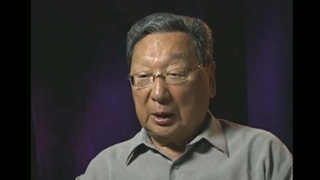Encountering a train full of Japanese Americans being transported to a concentration camp
And then one time—this was very hush-hush—but a train stopped late one afternoon. I presume it came from the coast somewhere, and I serviced it with water, ice, and there was a guard on each end with the shades all drawn. I had to go inside to service the water. When I went in, that's all I saw: Japanese. All Isseis and Niseis, and I don't know about Sanseis, but all Japanese. I thought, “Holy crow! Holy mackerel!” Then it dawned on me, I inquired. They weren't supposed to talk, they weren't supposed to show their face, I wasn't supposed to do anything, but they were headed for Heart Mountain. And I says, “Oh.” I serviced them, and that was the last I saw of them. They went to Heart Mountain, Wyoming. And at a different time, another train came through during my shift that had nothing but evacuees on it, going to Heart Mountain.
Date: March 15 & 16, 2006
Location: Washington, US
Interviewer: Megan Asaka
Contributed by: Denshō: The Japanese American Legacy Project.
Explore More Videos

Neighbors' sympathy after Pearl Harbor
(1915 - 2011) Nisei florist who resettled in New York City after WW II. Active in Japanese American civil rights movement

No immediate impact after Pearl Harbor
(b. 1928) Doctor. Former Chair of the Japanese Canadian Redress Foundation.

Treatment of Japanese fishermen in Canada during World War II
(b. 1928) Doctor. Former Chair of the Japanese Canadian Redress Foundation.

Japanese newspaper supported by Canadian government during World War II
(b. 1928) Doctor. Former Chair of the Japanese Canadian Redress Foundation.


Life in camp as teenager
(1926 - 2012) Scholar and professor of anthropology. Leader in the establishment of ethnic studies as an academic discipline

Fun at concentration camp
Senshin Buddhist Temple minister and co-founder of Kinnara Taiko.

Hiding what happened in camp
(1922–2014) Political and civil rights activist.


Camp as a positive thing
(1922–2014) Political and civil rights activist.

His father describes the importance of photographing camp life
(1924-2016) Photographer and businessman.

Importance of education in achieving redress for incarceration
(1919-2014) Activist for civil rights and redress for World War II incarceration of Japanese Americans.


The birth of a novel through a conversation with her nephew
(b. 1934) Writer


Discover Nikkei Updates


June 25 (US) | June 26 (Japan)
Featured Nima:
Stan Kirk
Guest Host:
Yoko Murakawa

See exciting new changes to Discover Nikkei. Find out what’s new and what’s coming soon!
